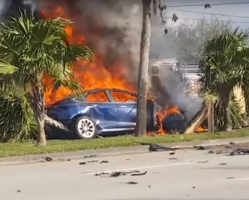— The death of 48-year-old Omar Awan in a 2016 Tesla Model S was allegedly caused by door handles that didn't "auto-present," and by an unreasonable fire risk from the battery.
According to the lawsuit, Awan was driving the Model S in South Florida on February 24, 2019, when the Tesla veered out of control and "yawed sideways, went over the curb and onto the median, and struck a palm tree."
The lawsuit says a police officer witnessed the crash and tried to open the doors but the handles were retracted.
According to Awan's wife, who filed the lawsuit, the Model S battery quickly caught fire and prevented bystanders and the officer from removing Mr. Awan. The lawsuit alleges Awan was alive after the Model S hit the tree, and he allegedly had no broken bones or internal injuries.
However, the flames quickly engulfed the car and burned Omar Awan beyond recognition.
The plaintiff claims the door handles failed and prevented the rescue of Mr. Awan, making the Tesla a "death trap."
The lawsuit says the door handles on the Model S are described by the automaker as, “automatic door handles [that] auto-present upon approach and withdraw when closed.”
According to the lawsuit, the Tesla was defective and dangerous from the time it was designed and sold, and the plaintiff claims it wasn't even crashworthy. In addition, the door locks were allegedly defective, the battery was unstable and the Model S was prone to intense fires that prevented Awan's rescue.
Although the lawsuit alleges the door handles couldn't be used, Tesla says the doors can be opened from the inside if the exterior handles don't function. However, the lawsuit doesn't say why the police officer who couldn't use the handle didn't break a window to open the door.
According to a detective with the Davie, Florida, police department, an officer attempted to break a window but the flames "were too strong and too big."
Local police and eyewitnesses to the crash said the Model S was traveling at a high rate of speed when it crossed three lanes of traffic, traveled into the median and crashed into palm trees.
Eyewitnesses estimated Awan was traveling between 75 and 90 mph when the Model S went out of control, and a traffic investigator estimated the Model S was traveling 75 mph in a 50 mph zone.
One eyewitness told local media there was no way anyone could have saved Awan.
The autopsy report from Broward County says Awan died from “inhalation of products of combustion with a contributory cause of death of thermal injuries.”
A search of Broward County court records shows Awan was cited multiple times allegedly for speeding and for red light violations since 2011.
In response to the crash, Tesla said any high-speed crash can cause a car to catch fire, whether the vehicle is powered by gasoline or a battery.
The Omar Awan Tesla crash lawsuit was filed in the Circuit Court of the 17th Judicial Circuit for Broward County, Florida - Liliana Awan, vs. Tesla Motors, Inc, et al.

